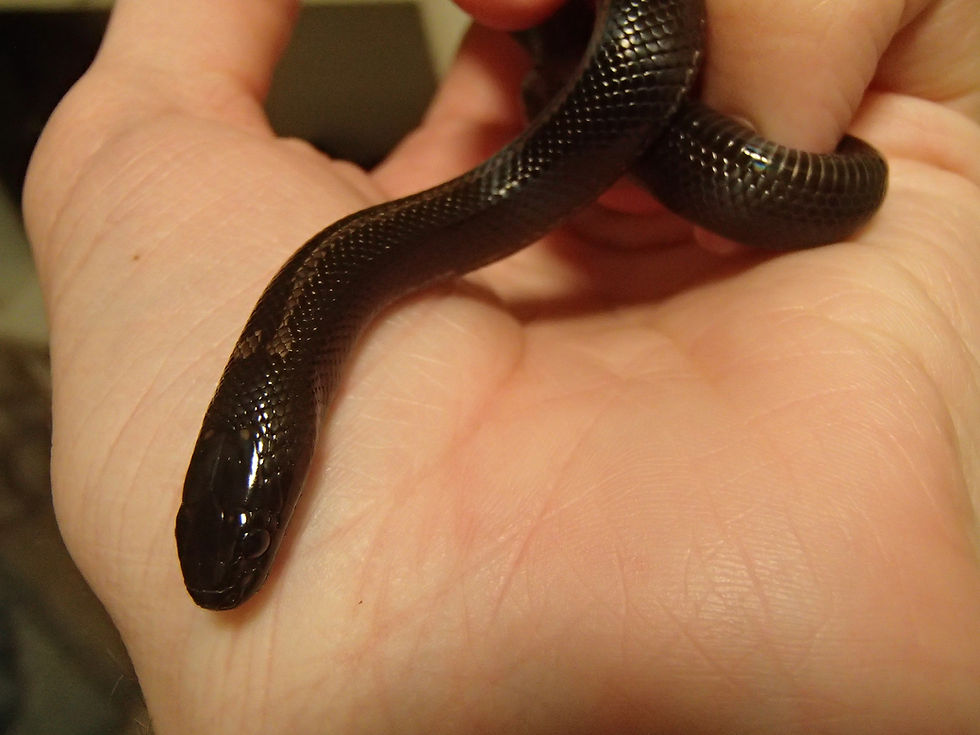Mischief in Black
- Carlton Carnivores
- Jul 21, 2019
- 4 min read
The most recent addition to the Carlton Carnivores family, alongside Cinder, is an oddball that I didn't even know existed until the last expo I visited where I picked the two up. Certainly a new personality type compared to the other snakes I have already (though rather a normal example of her species), this is Halailah, the Baja Kingsnake.

Once, the Baja King was considered its own subspecies; Lampropeltis getula is collectively known as the common kingsnake, and currently is generally recognized to have about 8 subspecies that range from Florida north to New York, and then eastward along the southern half of the US to California and the northern half of Mexico. Formerly known as L. g. nitida, the Baja form has now been lumped in with L. g. californiae, the familiar California kingsnake, and is merely considered to be a special locality of that subspecies.
Baja Kings are as the name suggests endemics to the Baja California peninsula, and more so only the very southern tip of the peninsula, where they inhabit the rocky desert environment there and especially prefer crevice-filled and brush-covered outcrops or regions near water sources and heavier vegetation. Like other localities of California king, they can be rather variable with bands, striping, or incomplete banded blotches in variable amounts of tan to deep brown on chocolate to black backgrounds, though commonly the "nitida" term is reserved by keepers for the very dark overall, striped individuals like Halailah. In all pattern variants though, this form is particularly characterized by dark coloration, with babies often starting out almost universally black and adults ranging from black to chocolate brown with deep brown to medium-tan patterning.

The most coveted versions of "nitida" are the extremely dark individuals with the striped pattern down the back; often this stripe starts a short ways behind the head, and may continue whole or broken all the way to the tail tip. Halailah is one that has a nearly unbroken stripe, but with an additional spot near her head and short breaks right near the end of her tail. As she gets older, she may retain the current very dark color she has, or the stripe may lighten and become more visible against a black or chocolate background. Personally, I'm hoping she remains closer to as she is now. Like other California kingsnakes, they also average out at around 3-4 feet in length when mature, though can occasionally push over 5 (with their very desert habitat and effects thereof, this locale may lean a little more toward the smaller side however).


Concerning Halailah herself: her name derives from her color, Halailah being Hebraic for "night," and she is so far epitomizing a rather well-known trait of many of the larger kingsnakes, especially the common king: they'll eat anything, or try to, if they can grab it. Jokes are often passed around reptile groups in form of images with captions such as "If I spies it, I tries it" or "If I sees it, I squeeze it," and this little pistol certainly has that tendency about her. Pinkie mice aren't too hugely interesting to her (I had to actually scent a couple with another snake to get her going at first, and now it takes some chasing around the cage before she actually grabs them), but for whatever reason she absolutely loves my fingers. Never mind that I am several hundred times her size, and certainly shouldn't smell like food, when I go to pick her up she'll coil firmly around one hand and then investigate me thoroughly in attempts to try and find a good spot to start munching. Not that it goes far, she couldn't get my own pinkie finger down let alone any of the other fingers and her teeth aren't even big enough to break skin, but it's certainly odd and somewhat annoying to watch this foot long black noodle grabbing a finger and hanging on like there's nothing else in the world to eat. Even after being put back in the cage, she'll follow my hand out like she does the mice she's supposed to gobble.

Luckily, a little hand sanitizer or rubbing alcohol on the hands beforehand seems to help with the nibbling tendency, and one can hope that like other common kings with enough handling Halailah will eventually stop looking at me like food and more as just a chance to get out and exercise. Some keep that tendency their whole lives, and are among the most food-oriented snakes in the herpetocultural community, but every keeper tries to stay optimistic that their new arrivals will focus on real food eventually. If this one does stay a little mischief maker, ah well...not every snake can or will be as docile and well-behaved as Irwin the sand boa or Midnight the corn, and she will provide a good lesson in that every snake is an individual, with their own quirks and sometimes cheeky personalities, and should be appreciated as they are even then.


Good rreading this post